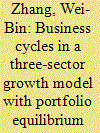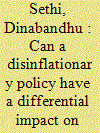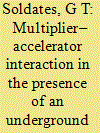| Srl | Item |
| 1 |
ID:
159347


|
|
|
|
|
| Summary/Abstract |
This study generalises a growth model proposed by Zhang (2016) through allowing all the time-dependent variables to be time-dependent. Zhang’s model deals with dynamic interdependence between capital accumulation and environmental change, with portfolio equilibrium among land, gold and physical wealth in a multi-sector general equilibrium framework. The model explains the dynamics of prices, rents and distribution of land, gold, physical wealth and environmental change on the basis of micro-economic foundation. This article generalises the model to explain business cycles due to different exogenous shocks. We simulate the motion of the economy and conduct comparative dynamic analysis to demonstrate business cycles due to periodic oscillations in the propensity to use gold, the propensity to consume housing, the propensity to consume industrial goods, the propensity to consume agricultural goods, the propensity to save, and the tax rate on the consumption of industrial goods.
|
|
|
|
|
|
|
|
|
|
|
|
|
|
|
|
| 2 |
ID:
159346


|
|
|
|
|
| Summary/Abstract |
This article examines the sectoral impact of disinflationary monetary policy by calculating the sacrifice ratios for several Organisation for Economic Co-operation and Development (OECD) and non-OECD countries. Sacrifice ratios calculated through the episode method reveal that disinflationary monetary policy has a differential impact across three sectors in both OECD and non-OECD countries. Of the three sectors, the industry and service sectors show significant output loss due to a tight monetary policy in OECD and non-OECD countries. But the agricultural sector shows a differential impact of disinflation policy: It shows a negative sacrifice ratio in OECD countries indicating that output growth is insignificantly affected by a tight monetary policy while non-OECD countries yield positive sacrifice ratios, suggesting that the output loss is significant. Further, it is observed that sacrifice ratios calculated from aggregate data are different from ratios calculated from sectoral data.
|
|
|
|
|
|
|
|
|
|
|
|
|
|
|
|
| 3 |
ID:
159348


|
|
|
|
|
| Summary/Abstract |
In our study, we attempt to produce a more up-to-date input–output (I-O) table for India based on the supply and use table (SUT) of the economy and the new series of National Accounts Statistics (NAS). The resulting table has been used to estimate output multipliers for 25 sectors, and these have been compared with multipliers from the last set of I-O officially estimated for the country in 2007–2008. A key difference between the two sets of tables is the inclusion of inputs in the public administration sector in the more recent one, as a result of which the Type-I multiplier of this sector is greater than one in the latter table compared to one in the former. For the same reason, the Type-II multipliers obtained from the 2013–2014 I-O table are broadly higher than those obtained from the 2007–2008 I-O table. Validation has also been done by comparing gross value added (GVA) as a basic price obtained from the national accounts data for 2013–2014 with the GVA arrived at from the constructed I-O table.
|
|
|
|
|
|
|
|
|
|
|
|
|
|
|
|
| 4 |
ID:
159350


|
|
|
|
|
| Summary/Abstract |
This article introduces the underground economy into a standard multiplier-accelerator model with linear progressive income taxation. The main results are that this introduction increases the instability of the overall economy towards chaos, that tax policy plays a critical role in preserving stability even if in the sense of a uniform cycle and that the operation of the accelerator may be countering the negative effect of tax evasion on tax revenue.
|
|
|
|
|
|
|
|
|
|
|
|
|
|
|
|
| 5 |
ID:
159349


|
|
|
|
|
| Summary/Abstract |
This study analyses the public debt sustainability issue of 20 major Indian states using the Bohn framework for panel data from 2005–2006 to 2014–2015. It employs regular panel data estimation procedures and the penalized spline (p-spline) technique. The results indicate that the primary balance of state governments responds positively to high public debt, so debt policies are successful in sustaining the debt situation of Indian states as a whole. However, at the individual level, debt is sustainable only in 12 states; in 8 states, debt is unsustainable and so these states require corrective action. These findings may be useful to policymakers and other stakeholders to formulate appropriate strategies to improve the debt situation of Indian states.
|
|
|
|
|
|
|
|
|
|
|
|
|
|
|
|
| 6 |
ID:
159345


|
|
|
|
|
| Summary/Abstract |
This study provides a quantitative evaluation of how the termination of the North American Free Trade Agreement (NAFTA) proposed by the Trump administration will affect the US textile and apparel (T&A) industry. By adopting the Global Trade Analysis Project (GTAP) computable general equilibrium model based on the GTAP9 database, the study finds that: first, the termination of NAFTA will significantly reduce US apparel imports from NAFTA members but lead to an increase of US apparel imports from Asian countries; second, ending NAFTA will substantially reduce US textile exports to the NAFTA region, which currently is the single largest export market for the US textile industry; and third, rather than encouraging more ‘Made in the USA’, the termination of NAFTA will reduce further the output of T&A manufacturing in the United States. The findings of this study augment our understanding of the potential economic impact of ending a major free trade agreement, which has been studied little, and shed new lights on the debate regarding the T&A-specific sectoral impact of NAFTA. The findings of the study also provide valuable inputs for policymakers regarding what should or should not be done with NAFTA from the perspective of the US T&A industry.
|
|
|
|
|
|
|
|
|
|
|
|
|
|
|
|